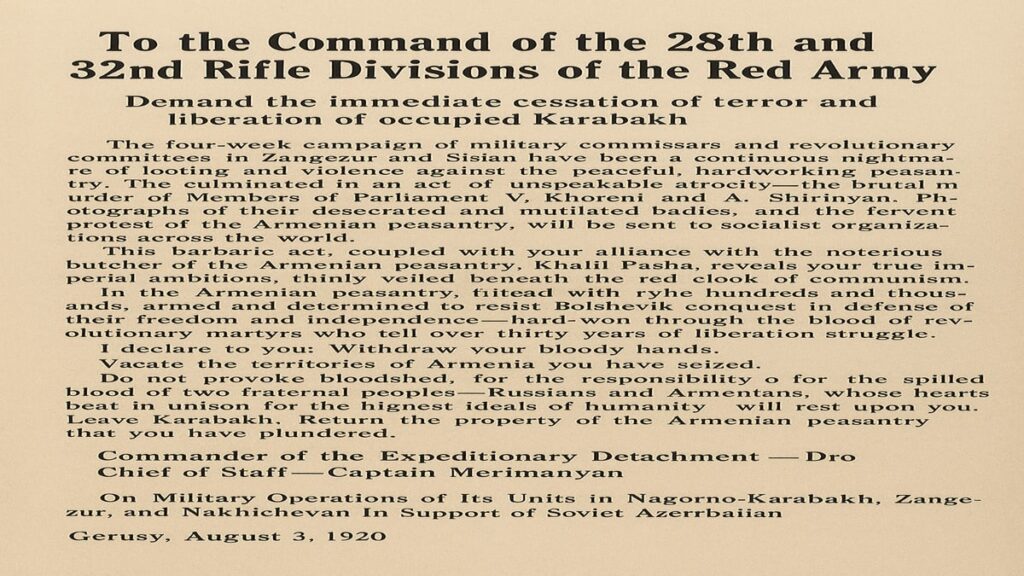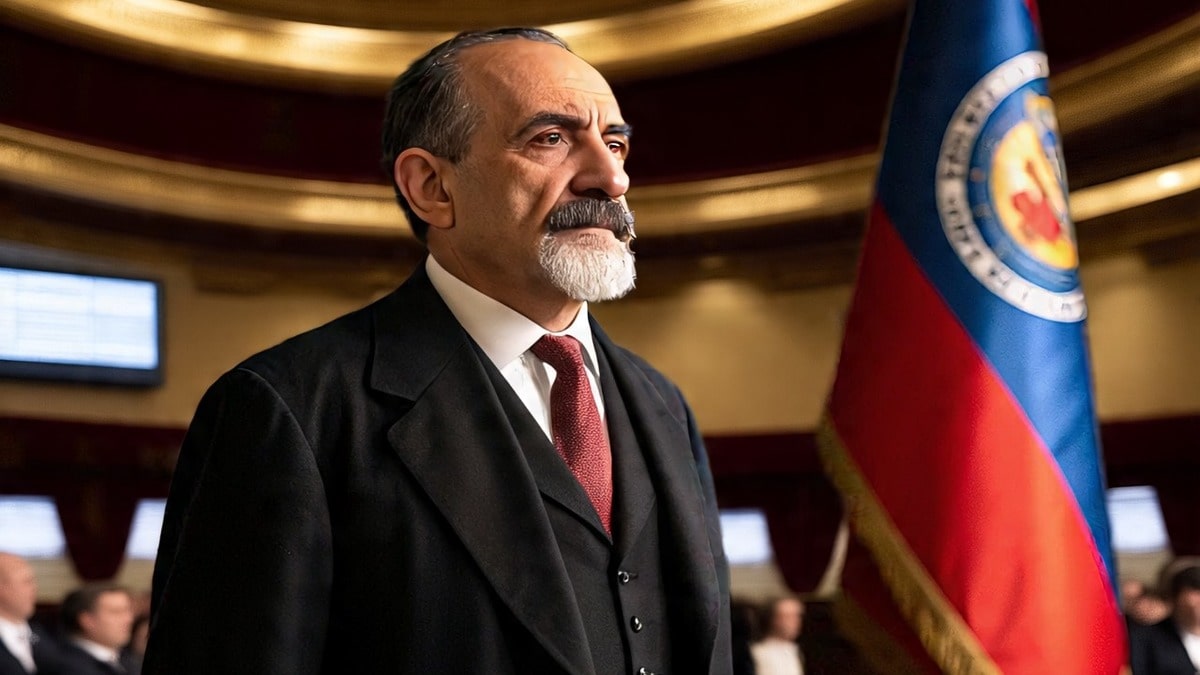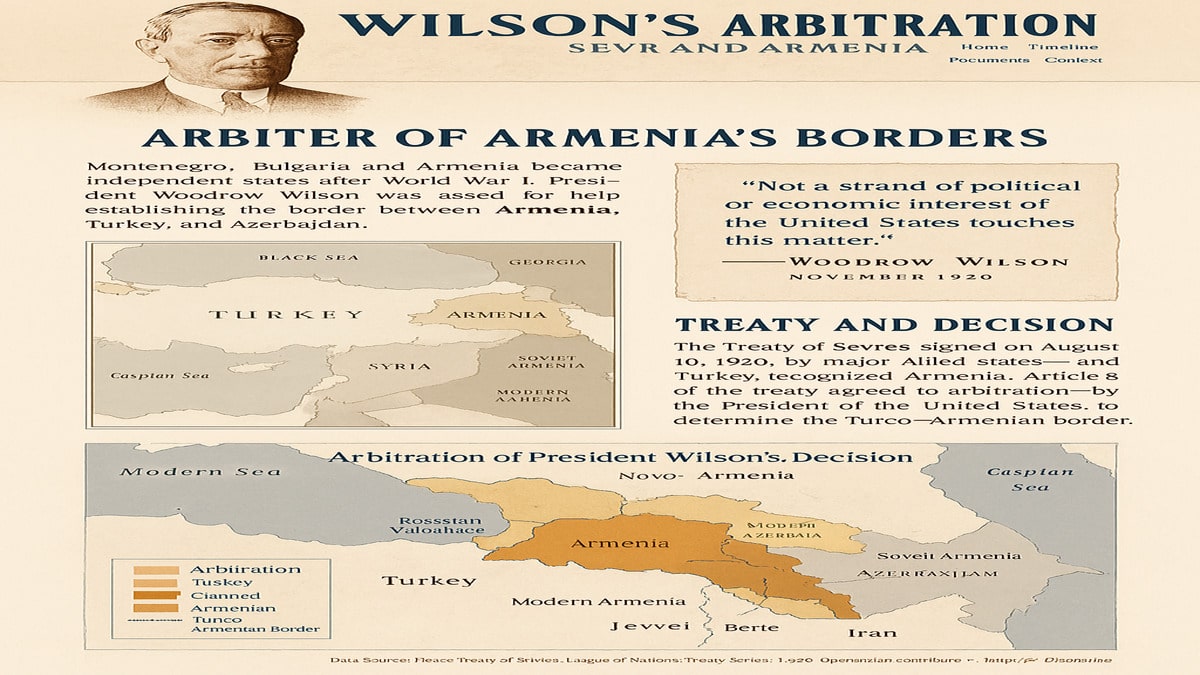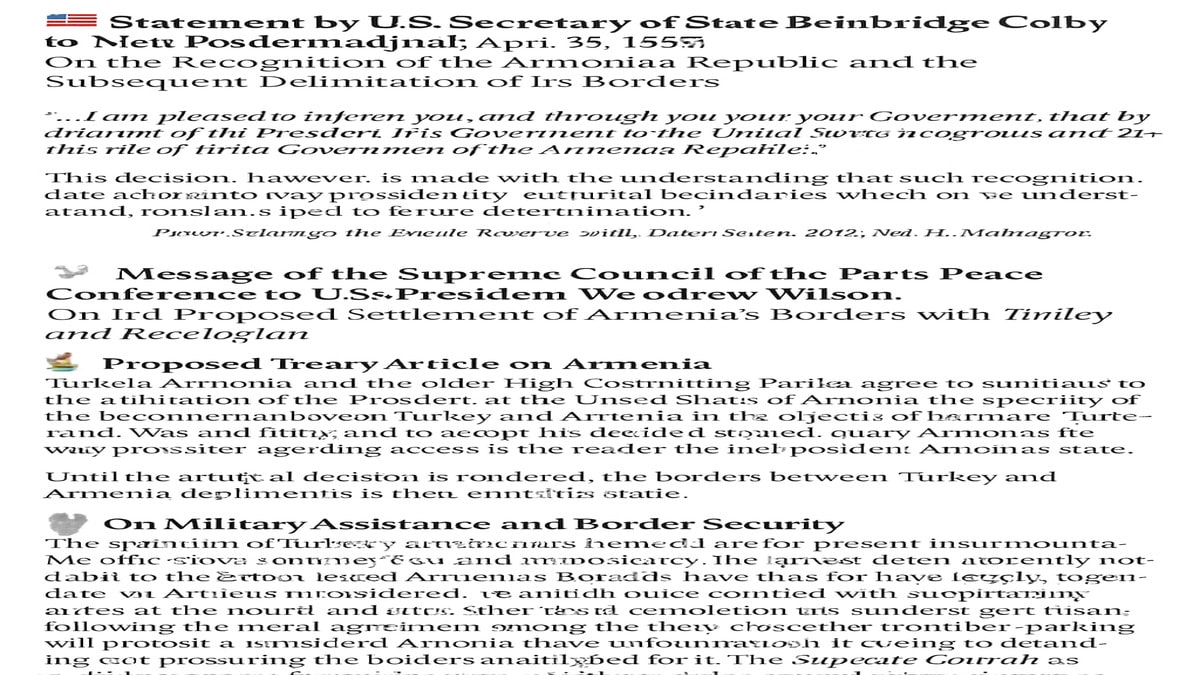
To the Command of the 28th and 32nd Rifle Divisions of the Red Army Demanding the Immediate Cessation of Terror and Liberation of Occupied Karabakh Gerusy, August 3, 1920
The four-week campaign of military commissars and revolutionary committees in Zangezur and Sisian has been a continuous nightmare of looting and violence against the peaceful, hardworking peasantry. It culminated in an act of unspeakable atrocity—the brutal murder of Members of Parliament V. Khoreni and A. Shirinyan. Photographs of their desecrated and mutilated bodies, along with the fervent protest of the Armenian peasantry, will be sent to socialist organizations across the world.
This barbaric act, coupled with your alliance with the notorious butcher of the Armenian peasantry, Khalil Pasha, reveals your true imperial ambitions, thinly veiled beneath the red cloak of communism.
The Armenian peasantry, filled with righteous indignation and fervent resolve, is rallying to my side by the hundreds and thousands, armed and determined to resist Bolshevik conquest in defense of their freedom and independence—hard-won through the blood of revolutionary martyrs who fell over thirty years of liberation struggle.
I declare to you: Withdraw your bloody hands. Vacate the territories of Armenia you have seized. Do not provoke bloodshed, for the responsibility for the spilled blood of two fraternal peoples—Russians and Armenians, whose hearts beat in unison for the highest ideals of humanity—will rest upon you. Leave Karabakh. Return the property of the Armenian peasantry that you have plundered.
Commander of the Expeditionary Detachment – Dro Chief of Staff – Captain Merimanyan Source: CGASA, f. 1328, op. 1, d. 555, l. 24. Certified copy. Typescript. Published in: Nagorno-Karabakh in 1918–1923, Yerevan, 1992, doc. no. 390 (Emphasis ours – Yu.B.)
🪖 Excerpt from the Order of the Command of the 11th Red Army
On Military Operations of Its Units in Nagorno-Karabakh, Zangezur, and Nakhichevan In Support of Soviet Azerbaijan Field Army, August 3, 1920
In Zangezur Uyezd, General Dro is advancing against the cavalry brigade of the 32nd Division and has taken Engelyurt. The main forces of Armenia are directed toward Nakhichevan with the aim of clearing the region of Turkish troops and suppressing the Muslim uprising… In the Armenian rear, bandit gangs operating in the southern part of Nagorno-Karabakh and along the banks of the Araks have been dispersed, and no further bandit groupings are observed. Cavalry units of the 28th Division have entered Nakhichevan and established contact with Turkish forces.
In order to defend the borders of Azerbaijan and allocate army forces accordingly, I hereby order:
- The commander of the 20th Rifle Division shall establish border outposts and keep brigades concentrated. Particular attention must be paid to the Armenian border, where, by maintaining an active posture, Dashnak incursions must be prevented. Any attack by Dashnaks must be met with retaliatory strikes on the area from which the attack originated, and the perpetrators must be dealt with harshly to deter further aggression against the peaceful population.
- The commander of the 28th Rifle Division shall deliver a concentrated and decisive blow to eliminate Dro’s rogue bands and reestablish contact with Nakhichevan and the Turkish Bayazet Division. The commander of the 18th Cavalry Division shall continue to secure the occupied region with one brigade, while immediately dispatching the second brigade through Balasaltanlu to strike the rear of the Dashnak band occupying Gerusy. The operation must be executed swiftly and decisively, with the complete destruction of the bandits.
- In the event of Dashnak band attacks from Armenian territory, they must be mercilessly destroyed, even if this requires crossing the border.
Commander of the 11th Army – Vasilenko Member of the Revolutionary Military Council – ** Chief of Staff – Remezov Source: CGASA, f. 195, op. 3, d. 216, l. 29–30 and verso. Original. Typescript. Published in: Nagorno-Karabakh 1918–1923, Yerevan, 1992, doc. no. 389 (Emphasis ours – Yu.B.)
📡 Telegram from the Minister of Foreign Affairs of Armenia
A. Ogandzhanian to the People’s Commissar for Foreign Affairs of the RSFSR G. Chicherin, Plenipotentiary Representative in Armenia B. Legran, and Head of the Armenian Mission in Georgia T. Bekzadyan Protesting the Occupation of Armenian Territories—Karabakh, Zangezur, and Nakhichevan—by Soviet Troops August 3, 1920
In response to your telegram dated July 29, received in Erivan on August 2, I must convey the following:
In numerous prior telegrams addressed to People’s Commissar Chicherin, my government has repeatedly pointed out the fundamental discrepancy between the friendly assurances of the Russian Soviet government and the actions of local authorities and commanders of the Soviet troops stationed in Azerbaijan.
The assertion by Commissar Chicherin that the Soviet government “has firmly resolved to assist the Armenian people in the severe trials it has endured and continues to endure, and intends to take measures to establish order along Armenia’s borders and create conditions for the life, capacity, and peaceful development of the Armenian people,” has in reality manifested as a series of continuous hostile military operations against Armenia, including repeated violations of its borders and the occupation of numerous indisputably Armenian regions.
These actions—ongoing in the advance of Soviet forces into Karabakh, Zangezur, and Nakhichevan—stand in stark contrast to Chicherin’s claim that “the Armenian people can firmly rely on the unwavering friendship of Soviet Russia and its assistance, within its means, to prevent further bloodshed.” Contrary also to the assurances of the Soviet government regarding its intention to support the expansion of the Republic of Armenia to ensure the viability of the Armenian people, in practice Armenia’s territory is being steadily reduced, with ever more regions seized—first Karabakh, then Zangezur, and now Nakhichevan.
Without awaiting the consent of my government to its proposed mediation in resolving border disputes between Armenia and Azerbaijan, the Soviet government is now imposing its decisions by force, consistently favoring its ally Azerbaijan. Moreover, it is extending its decrees to regions that have never been considered disputed, such as Armenian Karabakh, Zangezur, and Nakhichevan.
Meanwhile, individual commanders of Soviet detachments in Azerbaijan are continuously issuing ultimata to Armenia, demanding the withdrawal of Armenian forces from various indisputably Armenian regions, under threat of military action should these demands be refused. As recently as today, the commander of the 11th Red Army, Vasilenko, issued a similar ultimatum to the commander of the Armenian Republic’s forces, demanding unhindered passage of Soviet troops into Armenian territories—Zangezur and Nakhichevan—under the pretext of preventing alleged interethnic clashes between Turks, Tatars, and Armenians. The deadline for compliance is set for August 5, after which Commander Vasilenko threatens Armenia with a series of devastating strikes.
The Soviet government must recognize that such actions by its military commanders, and their advance into Armenia along a path once charted by the former Musavat government and Turkish imperialists, can only be perceived by the Armenian people as the implementation—through Soviet force—of the old Musavat plan to connect with imperialist Turkey through the living body of Armenia.
Under these conditions, all meaning and trust in the sincerity of the Soviet government’s friendly assurances are lost, and the actions of Soviet troops take on the character of military aggression aimed at realizing the imperialist designs of Turkey and Azerbaijani counterrevolutionaries, who seek to eliminate the very possibility of a free Armenia’s existence.
Faced with this mortal threat, the Armenian people will be compelled to exercise the sacred right of every nation—to defend its independence and the inviolability of its homeland’s borders by all means available.
My government, like the Armenian people as a whole, has sincerely sought and continues to seek the establishment of friendly relations with Soviet Russia.
Minister of Foreign Affairs of Armenia A. Ogandzhanian
Sources: RGASPI, f. 64, op. 1, d. 21, ll. 50–52. Copy. Typescript; AVPR, f. 148, op. 3, p.1, d. 3, ll. 10–10 verso. Copy; CGIA Armenia, f. 200, op. 1, d. 581, ll. 220–222. Transcript. Typescript. (Emphasis ours – Yu.B.)
- In the original text, “Soviet” was mistakenly rendered as “joint.”
🪖 Order from the Command of the Caucasian Front
To the Command of the 11th Red Army Classifying Armenia’s Actions to Defend Its Territorial Integrity as “Hostile” August 4, 1920
To the Commander of the 11th Army, copy to the Supreme Commander. August 4, 3:30 a.m. Karga, 10 versts.
In light of Armenia’s hostile actions against our forces in the Gerusy–Nakhichevan region, I ORDER:
To halt the further advance of Armenian troops and restore the lost positions, accelerating the deployment of units from the 18th Cavalry Division to the Julfa–Ordubad area. Report upon receipt and await further instructions.
Order No. 9043/s Commander of the Caucasian Front – Gittis Member of the Revolutionary Military Council – Trifonov Chief of Staff of the Front – Pugachev Source: RGVA, f. 195, op. 11, d. 24, l. 17.
🛡 Response from General Nazarbekov, Commander of the Armed Forces of Armenia
To the Command of the 11th Red Army On the Right to Defend the State’s Integrity from External and Internal Threats And the Unacceptability of Military Commanders Usurping Governmental Authority in Territorial Disputes Baku, August 6, 1920
I hereby transmit a copy of the response received to our ultimatum of August 1, 1920, addressed to the Armenian command:
“Re: No. 02447. The armed forces of Armenia safeguard the state against threats to its existence—whether from external enemies or internal insurgents—regardless of nationality or religion, when such threats endanger the integrity of the state. This is the duty of the armed forces of every nation. If Azerbaijani or Turkish troops invade Armenian territory, they will naturally be met by Armenian forces. As for the resolution of broader territorial disputes, such matters cannot be decided by military commanders and must be resolved by the respective governments. Our government has a delegation in Moscow for negotiations.”
Commander of the 11th Army Operations – V. Voronkov Military Commissar – Babaev Source: CGASA, f. 195, op. 3, d. 207, l. 735. Certified copy. Typescript. Published in: Nagorno-Karabakh in 1918–1923, Yerevan, 1992, doc. no. 393 (Emphasis ours – Yu.B.)
🤝 Preliminary Conditions for a Treaty Between the RSFSR and Armenia
Submitted by the Armenian Government to B. Legran Tiflis, August 6, 1920
- Cessation of all military operations and actions directed by either party against the other.
- Termination of all ultimatums and aggressive measures by local authorities, military command, and armed units of the Republic of Armenia.
- Withdrawal of Soviet troops from occupied regions and restoration of the status quo ante prior to their incursion into Armenian Karabakh and the Ijevan district (the mountainous part of the former Kazakh district).
- No deployment of Armenian military units into Armenian Karabakh and the mountainous part of the Elisavetpol district.
- Free passage granted by the Armenian government to Soviet military units that entered the Nakhichevan district en route to Azerbaijan.
Delegates of the Armenian Government Source: RGASPI, f. 64, op. 1, d. 21, l. 39. Copy. Typescript.
📝 From the Letter of S. Kirov, Plenipotentiary Representative of the RSFSR in Georgia
To People’s Commissar for Foreign Affairs G. Chicherin On the Main Argument of Soviet Azerbaijan in Territorial Disputes with Armenia And the Proposal to Convene a Conference for Their Resolution August 6, 1920
Another defining aspect of the political situation here is the Armenian question. I have done everything possible to implement your directive. Unfortunately, the result is dismal—no progress has been made. Due to recent events in Zangezur and the Nakhichevan district, the Armenian issue has demanded considerable attention. The Azerbaijani People’s Commissar for Foreign Affairs, Guseynov, was here for an extended period with several staff members. I held multiple consultations with him and the Armenian representative, including joint meetings. The only concession I secured from the Azerbaijanis was their willingness to cede the Sharur-Daralaghez district to Armenia. However, they categorically claim Nakhichevan, Ordubad, Julfa, Zangezur, and Karabakh as unquestionably theirs. Armenian representatives, in turn, firmly assert their claims to these regions. The main argument of the Azerbaijanis is that these territories belonged to Azerbaijan under the Musavat government, and ceding them now would, in their view, discredit Soviet authority not only in Azerbaijan but also in Persia and Turkey. Both Armenian and Azerbaijani representatives have proposed convening a peace conference to resolve all disputed issues, but neither side believes any agreement can be reached. The situation here is utterly hopeless. As I have already informed you, the only solution is to resolve this matter decisively in Moscow—only its authority can settle the issue. Delay is unacceptable, as ongoing clashes and systematic massacres in the disputed regions severely undermine our policy here, being attributed either to malicious intent or helplessness.
Source: RGASPI, f. 80, op. 4, d. 106, ll. 1–2. Copy. Published in: Kirov S. M. Articles, Speeches, Documents, Moscow, 1936, pp. 229–237; The Struggle for the Victory of Soviet Power in Georgia (1917–1921), Tbilisi, 1958, doc. no. 608, pp. 613–614, 617–618. (Emphasis ours – Yu.B.)
📡 Telegram from the Commander of the 11th Red Army Vasilenko,
Member of the Revolutionary Military Council Lukin, and Chief of Staff Voronkov To the Plenipotentiary Representative of the RSFSR in Georgia, S. Kirov (Copy to the Revolutionary Military Council of the Caucasian Front) On the Ultimatum Issued to the Government of Armenia Baku, August 6, 1920
Since the entry of the Red Army into Soviet Azerbaijan, the Armenian command has pursued a provocative, expansionist, and marauding policy, which has recently escalated into open military aggression by General Dro’s forces against the Red Army.
Prior to the occupation of Shusha by our units, General Dro’s detachment—comprising up to 500 rifles, 200 sabers, seven machine guns, and two artillery pieces—was positioned 15 versts east of Shusha. Following our occupation of Shusha and advance toward Gerusy, Dro’s forces retreated toward Bazaryan and entrenched themselves on the eastern slopes of the Syrdar ridge near Kushi-Belyan.
No active operations were undertaken, except for the dispatch of individuals to the Gerusy area to conduct anti-Soviet agitation. On July 21, the names of such agitators—Agerbek, Yasabek, Askerbya, and others—were identified.
On July 31, coinciding with the movement of our mission’s secretariat to Turkey, General Dro launched an offensive toward Engel-Yurt with 400 rifles, 400 sabers, four artillery pieces, and thirty machine guns. Under pressure from superior enemy forces, our units withdrew from Engel-Yurt. The enemy, aided by a population swayed by propaganda, seized the property and valuables of our mission.
Our command (specifically the commander of the 28th Division) issued an ultimatum to General Dro demanding that he vacate the occupied area within 48 hours and return the seized property. The ultimatum emphasized that the Red Army’s presence in Zangezur and Nakhichevan was not for conquest, but to halt the mutual massacres between Armenians and Tatars, and that the Red Army had no intention of attacking the Armenian army.
No response to the ultimatum was received. Instead, Dro’s forces continued to press our units and occupied Gerusy. He is being assisted by bands under Colonel Nzhdeh, initially concentrated near the Govant industrial plants. During their advance, Dashnak forces are burning grain in Muslim villages.
It is therefore indisputable that both Colonel Nzhdeh’s bands and General Dro are supported by the Armenian government and are acting under the instructions of the Armenian High Command. This is evidenced by the fact that while Dro’s detachment near Shusha previously numbered 500 rifles and 200 sabers with seven machine guns and two artillery pieces, it now comprises up to 1,000 fighters with thirty machine guns and eight artillery pieces. The question arises: where did Dro obtain 23 additional machine guns, rifles, and ammunition? The answer is clear.
Furthermore, the recent activation of Armenian forces in the Kazakh region and their latest offensives near Shusha, Air Umboganis, and Tum are undoubtedly coordinated by the Armenian High Command with the approval of its government. The ultimatum recently sent by General Dro confirms that he is acting on government orders.
Thus, the Armenian command itself confirms the treacherous attack on Red Army units. In his official response to the ultimatum, Armenian Commander-in-Chief General Nazarbekov states that border issues should be resolved through negotiations between the republics’ representatives. Yet, by launching a treacherous assault on Red Army units, they appear to have chosen to resolve the border issue with fire and sword.
Warn the Armenian government: if it does not withdraw its forces to their original positions, the Red Army command will be compelled to order a full-scale offensive across the front to eliminate the entirety of White-Dashnak Armenia.*
Commander of the 11th Army – Vasilenko Member of the Revolutionary Military Council – Lukin On behalf of the Chief of Staff – Voronkov Source: RGVA, f. 109, op. 10, d. 52, l. 170, 170 verso, 171. (Emphasis ours – Yu.B.) 513
Yuri Barsegov “Nagorno-Karabakh in International Law and Global Politics”
Artatsolum
Read Also:
- Ancient and Medieval Sources on Artsakh (Karabakh) as Part of Armenia’s State Territory
- Message from Gandzasar Catholicos Esayi to Peter I August 10, 1716
- Memorandum Issued to Ivan Karapet Along with the Imperial Letter to the Armenian People Regarding Russia’s Readiness to Take the Armenians of Karabakh Under Its Protection June 3, 1723
- Decree of Peter I to the Armenian People Regarding Russia’s Willingness to Offer Protection to the Armenians of Karabakh
- On Armenian Hopes for Russian Assistance
- Report of Minas Vardapet to Peter I
- Contents of the Secret Letters from the Armenian Assembly and the Armenian Army of Karabakh to the Russian Emperor and Chancellor August 1724
- Contents of the Secret Letters from the Armenian Assembly and the Armenian Army of Karabakh to the Russian Emperor and Chancellor August 1724
- State Charter of Peter I On the Acceptance of the Armenian People Under the Protection of the Russian State and Their Resettlement from Karabakh to Newly Acquired Persian Provinces November 10, 1724
- Letters from the Catholicos and the Meliks of Karabakh
- Charter of Catherine I Addressed to the Armenian Assembly
- Message General Mkhitar—to the Russian Government
- The Armenian Assembly’s Request for Military Assistance June 19, 1727
- Result from Russia’s failure to fulfill its promises of assistance to the Armenians March 1736
- On the Issuance of the Decree Appointing Panah Khan
- Letter from General Potemkin to Prince Argutinsky with questions about the liberation of Armenia
- Appeal of Gandzasar Catholicos Hovhannes to Catherine II
- Letter from Melik Apov Iosifov to Provide Assistance to Russian Military Forces for the Liberation of Enslaved Karabakh
- Report of Prince G. Potemkin to Catherine II
- Request of General P. Potemkin to Prince G. Potemkin
- Letter from Archbishop Joseph Argutinsky to General P. Potemkin
- Memorandum to Catherine II on the Project for the Restoration of the Armenian Kingdom
- Decree of Paul I to General Count I. Gudovich
- Letter from Archbishop Joseph Argutinsky
- Report by State Councillor P. Kovalesky
- The Khan’s Vizier, Mirza Jamal Javanshir Karabakhsky
- From the Report of General Marquis Palluci to Alexander I
- The Gulistan Treaty – An Interstate Act of Iran’s Cession of the Karabakh Territory to Russia
- Report of General A. Yermolov to Alexander I Requesting the Waiver of Tax Arrears for the Karabakh Khanate
- LETTER FROM GENERAL A. YERMOLOV TO MEHTI-KULI KHAN
- Directive from General A. Yermolov to General I. Velyaminov
- Letter of Metropolitan Sarkis Hasan-Jalalyan To General A. Yermolov
- Letter from General I. Paskevich
- TREATY CONCLUDED BETWEEN RUSSIA AND PERSIA AT TURKMENCHAY
- Russian Military Historian V. Potto on the Essence of the Treaty of Turkmenchay
- Order of General I. Paskevich to Colonel L. Lazarev
- STATEMENT ON THE DIFFERING ATTITUDES OF ARMENIANS AND TATARS TOWARD THE ANNEXATION OF KARABAKH TO RUSSIA
- REPORT By the Acting Uezd Chief of the Dzhevanshir Uezd, D. Baranovsky
- From the Memoirs of a Member of the Russian National Council in Baku (1918–1919)
- “TREATY OF PEACE AND FRIENDSHIP” Between the Ottoman Empire and the Republic of Armenia
- Letter from A. Mikaelyan, Representative of the Karabakh and Zangezur Fellowship
- Note of Protest from the Ministry of Foreign Affairs of the Republic of Armenia
- Appeal of the Karabakh Armenian National Council To the Commander of Allied Forces in Baku
- LETTER FROM THE CHAIRMAN OF THE KARABAKH ARMENIAN NATIONAL COUNCIL
- Turks in Shushi
- Letter of Welcome from the Karabakh Armenian
- LETTER FROM GENERAL BAGRATUNI
- FROM THE MESSAGE OF THE ARMENIAN TELEGRAPH AGENCY
- REPORT FROM THE DIPLOMATIC REPRESENTATIVE OF ARMENIA IN GEORGIA
- Resolution of the Fifth Congress of Armenians of Karabakh
- Report by Prime Minister Hatisov to the Council of Ministers of Armenia
- FROM THE MEMORANDUM OF THE KARABAKH ARMENIAN NATIONAL COUNCIL
- 🇬🇧 ANNOUNCEMENT OF THE BRITISH MILITARY MISSION IN SHUSHA
- From the Memorandum of the Armenian Representative to the British Military Mission in Shusha
- Report from the Office of the Governor-General of Karabakh
- NOTICE FROM THE REPRESENTATIVE OF THE BRITISH MILITARY MISSION IN SHUSHI
- 🇬🇧 Doubts Expressed by British Delegate Eric Forbes Adam
- LETTER FROM THE ARMENIAN DIPLOMATIC REPRESENTATIVE
- Assessment by the Karabakh Armenian National Council
- “The Caucasian Word” on the Confirmation by a British Command Representative
- Letter from the Acting Governor-General of Karabakh
- OVERVIEW OF THE SITUATION IN THE CAUCASUS
- Proclamation of the Zangezur Armenian National Council
- Telegram from the Prime Minister of Armenia to the British High Commissioner
- MESSAGE TO THE DIPLOMATIC REPRESENTATIVE
- Photographic Evidence of the Annihilation of Shushi’s Thirty-Thousand Strong Armenian Population
- Appeal of the Karabakh Soldiers and Officers of the Armenian Army
- Territorial Dispute Between the Azerbaijan SSR (as part of the RSFSR) and the Republic of Armenia
- Telegram from the Minister of Foreign Affairs of Armenia
- Telegram from G. Ordzhonikidze to V. Lenin, I. Stalin, and G. Chicherin
- LETTER FROM MEMBERS OF THE CAUCASIAN BUREAU OF THE CENTRAL COMMITTEE OF THE RCP(B): A. AVANESOV, R. KATANYAN, AND AYKUNI
- Report of the Karabakh Community Delegation of Tiflis
- From the Report of People’s Commissar for Foreign Affairs of the RSFSR
- Letter from the People’s Commissar for Foreign Affairs of the RSFSR, G. Chicherin, to V. Lenin
- EXCERPT FROM THE MINUTES OF THE MEETING OF THE POLITBURO
- LETTER FROM MEMBERS OF THE CAUCASUS BUREAU OF THE CENTRAL COMMITTEE OF THE RCP(B)
- LETTER FROM MEMBERS OF THE CAUCASUS BUREAU OF THE CENTRAL COMMITTEE OF THE RCP(B) 11TH RED ARMY
- Telegram from the People’s Commissar for Foreign Affairs of the RSFSR, G. Chicherin


